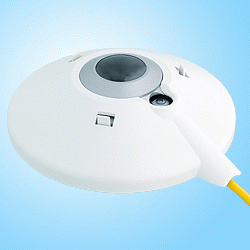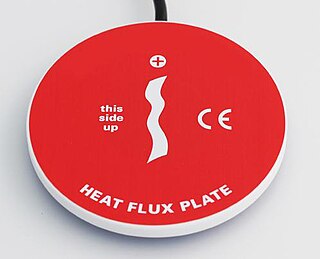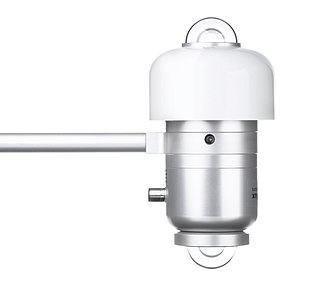This article needs additional citations for verification .(July 2018) |

ISO 9846,Solar energy -- Calibration of a pyranometer using a pyrheliometer, is the ISO standard for the calibration of a pyranometer using a pyrheliometer. [1]
This article needs additional citations for verification .(July 2018) |

ISO 9846,Solar energy -- Calibration of a pyranometer using a pyrheliometer, is the ISO standard for the calibration of a pyranometer using a pyrheliometer. [1]

A light meter is a device used to measure the amount of light. In photography, a light meter is used to determine the proper exposure for a photograph. The meter will include either a digital or analog calculator which displays the correct shutter speed and f-number for optimum exposure, given a certain lighting situation and film speed. Similarly, exposure meters are also used in the fields of cinematography and scenic design, in order to determine the optimum light level for a scene.

In photography, exposure value (EV) is a number that represents a combination of a camera's shutter speed and f-number, such that all combinations that yield the same exposure have the same EV. Exposure value is also used to indicate an interval on the photographic exposure scale, with a difference of 1 EV corresponding to a standard power-of-2 exposure step, commonly referred to as a stop.

Actinometers are instruments used to measure the heating power of radiation. They are used in meteorology to measure solar radiation as pyranometers, pyrheliometers and net radiometers.
A pyranometer is a type of actinometer used for measuring solar irradiance on a planar surface and it is designed to measure the solar radiation flux density (W/m2) from the hemisphere above within a wavelength range 0.3 μm to 3 μm.

A pyrgeometer is a device that measures near-surface infra-red (IR) radiation, approximately from 4.5 μm to 100 μm on the electromagnetic spectrum.
ISO/IEC 17025General requirements for the competence of testing and calibration laboratories is the main ISO/IEC standard used by testing and calibration laboratories. In most countries, ISO/IEC 17025 is the standard for which most labs must hold accreditation in order to be deemed technically competent. In many cases, suppliers and regulatory authorities will not accept test or calibration results from a lab that is not accredited. Originally known as ISO/IEC Guide 25, ISO/IEC 17025 was initially issued by ISO/IEC in 1999. There are many commonalities with the ISO 9000 standard, but ISO/IEC 17025 is more specific in requirements for competence and applies directly to those organizations that produce testing and calibration results and is based on somewhat more technical principles. Laboratories use ISO/IEC 17025 to implement a quality system aimed at improving their ability to consistently produce valid results. It is also the basis for accreditation from an accreditation body.
Active cavity radiometer is an electrically self-calibrating, cavity pyrheliometer used to measure total and spectral solar irradiance.

A solarimeter is a pyranometer, a type of measuring device used to measure combined direct and diffuse solar radiation. An integrating solarimeter measures energy developed from solar radiation based on the absorption of heat by a black body. The principle this instrument was designed on was first developed by the Italian priest, Father Angelo Bellani. He invented the actinometric method which is based on physical and chemical techniques.

A pyrheliometer is an instrument for measurement of direct beam solar irradiance. Sunlight enters the instrument through a window and is directed onto a thermopile which converts heat to an electrical signal that can be recorded. The signal voltage is converted via a formula to measure watts per square metre.

Sun path, sometimes also called day arc, refers to the daily and seasonal arc-like path that the Sun appears to follow across the sky as the Earth rotates and orbits the Sun. The Sun's path affects the length of daytime experienced and amount of daylight received along a certain latitude during a given season.

A heat flux sensor is a transducer that generates an electrical signal proportional to the total heat rate applied to the surface of the sensor. The measured heat rate is divided by the surface area of the sensor to determine the heat flux.
The Brukkaros Solar Observatory was a solar observatory installed on Brukkaros Mountain in the ǁKaras Region of Namibia. It was financed and operated by a cooperation of the American National Geographic Society and the Smithsonian Institution, and it was operational between 1926 and 1931.

The Simple Model of the Atmospheric Radiative Transfer of Sunshine (SMARTS) is a computer program designed to evaluate the surface solar irradiance components in the shortwave spectrum under cloudless conditions. The program, written in FORTRAN, relies on simplifications of the equation of radiative transfer to allow extremely fast calculations of the surface irradiance. The irradiance components can be incident on a horizontal, a fixed-tilt or a 2-axis tracking surface. SMARTS can be used for example to evaluate the energy production of solar panels under variable atmospheric conditions. Many other applications are possible.
Loyal Blaine Aldrich was an American astrophysicist and astronomer of the Smithsonian Institution. Upon graduation from the University of Wisconsin in 1907, Aldrich became a Smithsonian Astrophysical Observatory assistant to Charles Greeley Abbot. The observatory conducted astrophysical research on solar radiation and the amount of energy from the sun that strikes the outer edge of the earth's atmosphere. Abbot became director of the observatory in 1907 and established solar observing stations in the United States, South America, and Africa to carry out research on solar radiation. Aldrich became director of the observatory from 1942 to 1955. Harvard University astronomy department chairman Fred Lawrence Whipple became director of the observatory when Aldrich retired.

Morgan Solar, Inc. is a Canadian solar power and optical technology company based in Toronto, Ontario. Since 2017, the company has specialized in urban sunlight management, led by its SPOTlight platform. The company also produces in situ IV curve tracers and optical film technologies.

Photovoltaic system performance is a function of the climatic conditions, the equipment used and the system configuration. PV performance can be measured as the ratio of actual solar PV system output vs expected values, the measurement being essential for proper solar PV facility's operation and maintenance. The primary energy input is the global light irradiance in the plane of the solar arrays, and this in turn is a combination of the direct and the diffuse radiation.

ISO 9060, Specification and classification of instruments for measuring hemispherical solar and direct solar radiation, is an ISO standard for the classification of pyranometers and pyrheliometers.

ISO 9847, Solar energy -- Calibration of field pyranometers by comparison to a reference pyranometer, is an ISO standard for the calibration of pyranometers.

An albedometer is an instrument used to measure the albedo of a surface. An albedometer is mostly used to measure the reflectance of earths surface. It is also useful to evaluate thermal effects in buildings and generation capacity with bifacial solar photovoltaic panels. Often it consists of two pyranometers: one facing up towards the sky and one facing down towards the surface. From the ratio of incoming and reflecting radiation the albedo can be calculated.